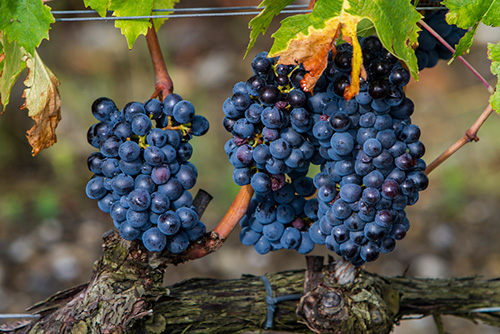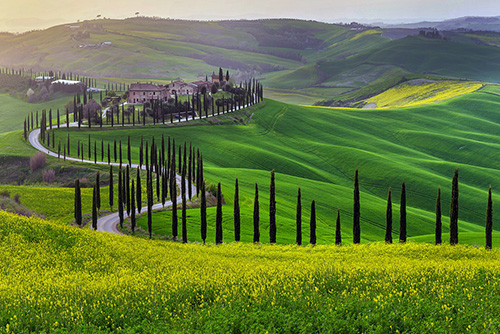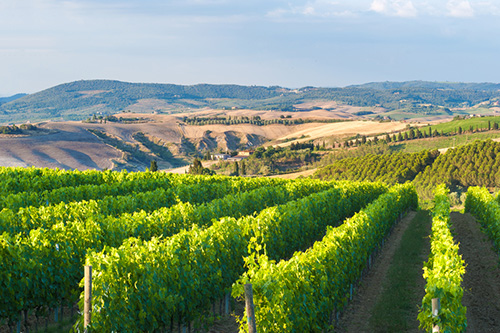Complete Guide to Sangiovese Wine | Wine 101

Sangiovese, when done right, exudes flavors ranging from red cherry to black plum, from vanilla to smoke, and from violets to tar. Indeed, it’s one of the few varietals that varies drastically from region to region.
Despite the relatively minuscule plantings of this grape, it has earned a reputation for being exciting, complex, and worthy of Tuscany’s near devotion.
This guide will take you through Sangiovese, from its notable growing regions, flavor characteristics, food pairings, and some excellent recommendations.
Characteristics of Sangiovese
Sangiovese is a grape that varies widely in flavor, depending on the region it is made in and the clones that are used.
There are at least 650 clones of Sangiovese, giving the grape much more diversity and variability than a typical French varietal. You can learn about some of the cataloged clones here.
The clones each represent the small mutation in a grapevine (and therefore grape) over time. They exist like a sub-species of the parent grape and retain all the key characteristics with some very slight differences.
But with all this variance, Sangiovese is typically low in tannins, high in acid, medium-bodied, and medium in alcohol at around 13-14%.
When enjoyed young, Sangiovese is known for being easy drinking, with flavors of cherry pie, pepper, spice, and violets. After aging, Sangiovese develops complex flavors of earth, tea, smoke, tar, and - depending on the barrels used - intense oak spice.
The most predominant growing region for Sangiovese is Italy, where it is equally enjoyed as a single-grape wine or blended with local Italian varietals such as the white wines Malvasia Bianca or Trebbiano, as well as non-native reds such as Cabernet Sauvignon.
In addition to being one of Italy’s premiere grapes, Sangiovese has been introduced to other regions such as Argentina and the United States. However, Italy’s ideal Mediterranean climate has proven to produce the best examples of Sangiovese to date.

The hills of Tuscany
Sangiovese Tasting Notes
As mentioned above, the flavors of Sangiovese depend on the region it is grown in, the clones that are cultivated in that region, and how long it is aged.
Similarly to Pinot Noir, Sangiovese has been split into hundreds of clones, each with ideal growing conditions.
For example, the clones used in Chianti and Chianti Classico differ from those used in Brunello di Montalcino; the resulting wines taste so different from one another that you’d hardly believe it’s the same grape.
Those used in Chianti Classico can be expected to have flavors of plum, dried cherry, white pepper, and a pleasant minerality, while Brunello's clones will have flavors of black cherry, tar, smoke, and black tea. Neither is better than the other, and the clones used are undoubtedly best suited for those specific growing regions.
As for aging, each region in Italy has its own rules regarding how long a wine must be aged before being released. However, most notable regions require a minimum of two years of aging, with specific requirements for barrel aging and bottle aging.
Still, winemakers will often allow their wines to age for longer than is required, as this helps smoothen harsh flavors and add delicate notes of oak and spice.
How is Sangiovese Served?
Sangiovese is best served in a standard red wine glass and at slightly colder than room temperature (60°-68°F). This allows for the acidity in Sangiovese to be preserved and prevents any harsh flavors from standing out.
Regarding decanting, Sangiovese from regions known for producing lighter, fruity, and less complex wines do not require decanting.
As for Sangiovese from most notable areas, or Sangiovese that has gone through extensive aging, these will benefit from decanting for at least 30 minutes-1 hour.
The Sangiovese Grape
The parent grapes of Sangiovese are Ciliegiolo and Calabrese Montenuovo, both of which originated in southern Italy. This fact proves Sangiovese is not native to Tuscany, though it is undoubtedly its most successful growing region.
Sangiovese is the predominant grape in Tuscany’s most infamous wines, such as Chianti, Brunello di Montalcino, and Vino Nobile di Montepulciano. Sangiovese may be the only grape used in these wines, or it may be blended with other grapes to accentuate the wine.

Sangiovese grapes growing in Montalcino
When Sangiovese is blended with other grapes, it can be made more suitable for early drinking - or just the opposite - it can be made better suited for extended aging.
For example, white grapes make the wine more drinkable, whereas high-tannin wines increase its age-ability.
When done right, Sangiovese is rich and complex, making it the perfect food pairing wine. When done poorly, however, the wine can taste dull, thin, and watery.
Notable Regions for Sangiovese
It's best known as an Italian wine grape but these days there are other notable regions across the globe.

Chianti, Italy
Chianti is Tuscany’s most prominent growing region and includes several subregions, most notably Chianti Classico.
Chianti has traditionally been blended with white grapes, including Malvasia Bianca and Trebbiano, to brighten the wine and reduce its aging time.
Unfortunately, this practice nearly backfired after the wine developed a reputation for being diluted, cheap, and watery.
This was true until the 1970s when innovative winemakers began steering away from adding white grapes in favor of 100% Sangiovese, or Sangiovese blended with Cabernet Sauvignon and other non-native grapes.
Today, Chianti produces wines rich with red cherry, plum, white pepper, smoke, and balsamic. Chianti Classico, with its microclimates and high-altitude growing region, is subject to extended aging and develops plus flavors of dried orange peel, cocoa, fig, leather, and earth.
Montalcino, Italy
If Chianti is the cherry pie of Sangiovese, then Brunello’s translation to “the nice dark one” should give you insight into the difference between them. Brunello is, in fact, Italy’s most expensive, rare, and revered example of the Sangiovese grape.
One sip of Brunello and your palate is rich with notes of blackberry, black cherry, raspberry, leather, cinnamon, chocolate, and violet. This is primarily due to the clones used, which in Brunello are collectively called, well, Brunello.
Aside from clones, Brunello di Montalcino vineyards sit at about 1,800 feet above sea level, allowing for warm days and cooling evenings. The soil type also contains more limestone, making for quick-draining and nutrient-poor soil, leading to low-yield and highly concentrated wines.
Within the region of Montalcino, there is also Brunello’s younger sibling, Rosso di Montalcino. Rosso is known for precisely the opposite of Brunello, with young, fruity, and simple wines expected from this region.
Montepulciano, Italy
The region of Montepulciano surrounds the city of Siena, near the southern end of the Valley of Chiana. Nicknamed “vino nobile,” this refers more to the poets and scholars who drink the wine than it does to the “nobile” wines that are made.
When done properly, Montepulciano wines can be refreshingly spicy, with a bitter finish and high acid. When done poorly, these wines can be thinned out, watery versions of Sangiovese. These wines are also made up of their own unique clones of Sangiovese, collectively known as prugnolo, or “little prune.”
Vineyards in this region are planted on broad slopes about 600 feet above sea level. The sandy clay soil is quick-draining and retains heat well, making for complex and concentrated wines.
Mendoza, Argentina
Similarly to Tempranillo, Sangiovese was introduced to Argentina by early Italian immigrants. While it showed promise, its success eventually became abused, and it was relegated to cheap jug wines.
Today, very little Sangiovese remains, as Malbec has become the predominant grape, though some winemakers hope to diversify and restore the success of Sangiovese.
Washington, USA
Early Italian immigrants eager to experiment with new varietals introduced Sangiovese to the states. As a result, it has shown promise in this region, though it still encompasses a tiny portion of vineyards. Mostly, bright and fruity rosé wines are made in Washington with the Sangiovese grape.
Sangiovese Food Pairings
Sangiovese’s high acid and diverse flavor profile make it the perfect food pairing wine for a host of cuisines - with Italian food being the obvious first choice.
When deciding which bottle of Sangiovese to crack open, it’s good to think about the region.
For example, Brunello is a dark and rich wine best served with equally rich dishes such as beef stew or pasta with meat sauce.
On the other hand, Rosso di Montalcino is a great easy-drinking wine that works well with roasted vegetables or pasta in a butter or pesto sauce.
Chianti is perhaps the most versatile, as it isn’t pulled too much in one direction or another. This makes Chianti a great pairing with pizza, burgers, or tomato-based Italian dishes like lasagna or ragu.
When in doubt, stick to what’s local. Tuscan soup or beef roasts are the region's favorite dishes, and they would pair perfectly with most Sangiovese wines.
3 Awesome Sangiovese Wines to Try
Get stared with Sangiovese with one of these lovely wines.
Under $15 - Ziobaffa Organic Toscana 2017

This organic Toscana is richly flavored with deep floral and fruity flavors. Subtle spice and perfectly balanced tannins make for a wine that pairs wonderfully with all sorts of dishes. This is a go-to bottle that is sure to satisfy various palates.
Under $30 - Dei Vino Nobile di Montepulciano 2018

Coming from Montepulciano, this wine is made with 90% Sangiovese and 10% Canaiolo Nero, making for a smooth and well-rounded wine with notes of cherries, plum, delicate spice, and a touch of leather. A long finish and balanced acidity make for an easy-drinking wine with a good structure.
Under $100 - Altesino Brunello di Montalcino 2017

A perfect example of all that Brunello has to offer, this wine is overflowing with aromas of ripe dark fruit with balanced flavors of earth, smoke, and spice. This highly structured wine has a long finish and smooth tannins unmistakable for a classic Brunello.
